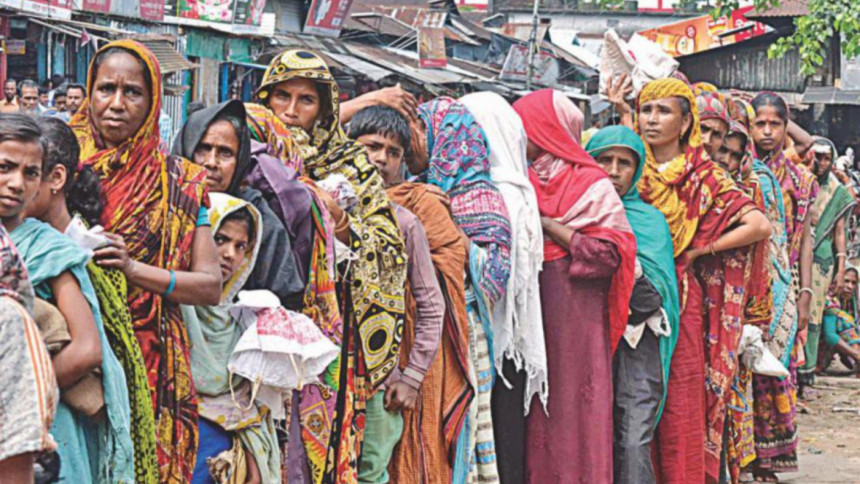Poverty’s Third Frontier

When Bangladesh gained independence nearly five decades ago, poverty was the default condition for over 80 percent of the population. Over the course of the 70s, 80s and 90s, the anti-poverty efforts of the state and society were directed against this general state of poverty. By the turn of the century, the poverty rate had been brought down to below 50 percent and again to below 33 percent by 2010, and further to around 25 percent by 2016. This was a significant achievement in which multiple actors including government, NGOs, social actors as well as ordinary citizens—women, farmers, entrepreneurs, youth, workers—played their roles.
By the 1990s, there was additionally an important new element in the fight against poverty, namely a recognition that while the instruments and policy approaches to combat general poverty must continue, there was a need to consider additional and specific steps for a worse-off group within the generally poor group. In an earlier publication Rethinking Rural Poverty (SAGE, 1995), we had termed this group "extreme poor", i.e. people who were not just poor but subsisted considerably below the poverty line. Our early research at Bangladesh Institute of Development Studies (BIDS), for example, had shown that micro-credit, which was an important instrument to combat poverty, was excluding the extreme poor because they often lacked critical capacities to make effective use of general microcredit. Out of such a realisation, from the 1990s onward, new programming initiatives both by government and NGO sectors emerged which were specifically designed for the extreme poor. These too have borne fruits because not only has general poverty come down, the rate of extreme poverty too has come down from a high of 34.3 percent in 2000 to 12.9 percent in 2016.
Notwithstanding this impressive achievement in combating poverty, the poverty challenge still remains large. In absolute terms, the number of poor by the 2016 data stood at around 39 million, while the number of extreme poor stood at just under 20 million. These are undoubtedly very large numbers which call for sustained continuation of anti-poverty efforts. However, beyond the large unfinished business of general and extreme poverty per se, there is a third poverty frontier that now merits attention. This is the hitherto largely out-of-focus but entrenched problem of exclusion and marginalisation.
Economists have understood the problem of poverty and extreme poverty in terms of a lack—lack of income or lack of resources or, as Amartya Sen pointed out, lack of capabilities. The excluded and marginalised groups may also be lacking all of the above, but what distinguish them from the general category of poor and extreme poor are the walls of discrimination and highly negative social perceptions that not only often render them socially and statistically invisible, but also serve to downgrade their own sense of self-worth and their sense of agency. Not surprisingly, while many among the poor have embraced an aspirational mindset which refuses to accept that "poverty is destiny", the excluded and marginalised groups struggle to make a transition to such a mindset.
Having won significant victories in the fight against poverty and extreme poverty despite the challenges that remain, the policy moment is right for policymakers, analysts and implementing agencies alike to take cognisance of—and prioritise—poverty's third frontier, namely, exclusion and marginalisation. It is not surprising that the World Bank's 2018 poverty assessment points towards a slowing down in the rate of poverty reduction after 2010. Arguably this is partly due to the nature of the growth strategy being pursued particularly over the last decade, but equally arguably, this is also due to those stratums of extreme poverty who are caught in entrenched poverty traps because of exclusion and marginalisation.
The "No One Left Behind" slogan of SDGs is not merely a programmatic guideline. To my mind, this slogan is the philosophical bedrock on which the ambitions of SDGs stand. The focus has to be not just on those who are racing ahead but also on those at the farthest end of the line, often entrapped by statistical invisibility and prevalent negative attitudes within society. It is these groups who constitute the third poverty frontier which has now to be transformed into a priority if the momentum on combating poverty is to be sustained.
For a long time, the discussion on excluded and marginalised communities has tended to narrowly focus on the plight of hill peoples, particularly in the Chittagong Hill Tracts. Extensive research by the Society for Environment and Human Development (SEHD), Power and Participation Research Centre (PPRC), and other partners has clearly established the necessity of a broader focus particularly covering a plethora of small communities across the plains of Bangladesh. Many of these communities are numerically small and thus struggle to project a collective identity, but together comprise a sizeable population group upward of five million. They include tea workers and Khasis in north-east, Santals in north-west, Jaladas in south-east, Bede along major rivers, sweepers in cities, Koira and Rishi in central and south-west and many others. Their marginality and exclusion are driven by multiple factors: social and economic discrimination of ethnic minorities such as tea workers, khasis, Santals; stigmatised occupations such as those of sex workers and sweepers; disappearing traditional occupations due to urbanisation and economic modernisation such as those of Bede, Rishi, Koira, Jaladas; and finally, marginalisation due to political displacement such as Biharis.
Addressing the third frontier of poverty requires a multi-pronged approach as championed by SEHD, PPRC and partners. The multi-year research and consultations pursued by these agencies over the preceding years have underscored, if anything, the critical need for making the excluded groups statistically visible through credible research as an essential first step to scale up policy and programmatic attention. It is indeed with this objective in mind that SEHD and PPRC are launching the Report on the State of the Excluded and Marginalised, as the start of a possible annual series. The report combines a comprehensive mapping of excluded and marginalised groups, analysis of their specific vulnerabilities and needs, and strategies to overcome the traps of exclusion and marginalisation including capacity development for self-advocacy. As the government begins the process of formulating the 8th Five-Year Plan, it may be useful and indeed necessary to take cognisance of such findings and analysis of poverty's third frontier, for the latter to be effectively addressed.
Hossain Zillur Rahman is Executive Chairperson, Power and Participation Research Centre (PPRC), and a former advisor in the Caretaker Government of Bangladesh.


 For all latest news, follow The Daily Star's Google News channel.
For all latest news, follow The Daily Star's Google News channel. 



Comments